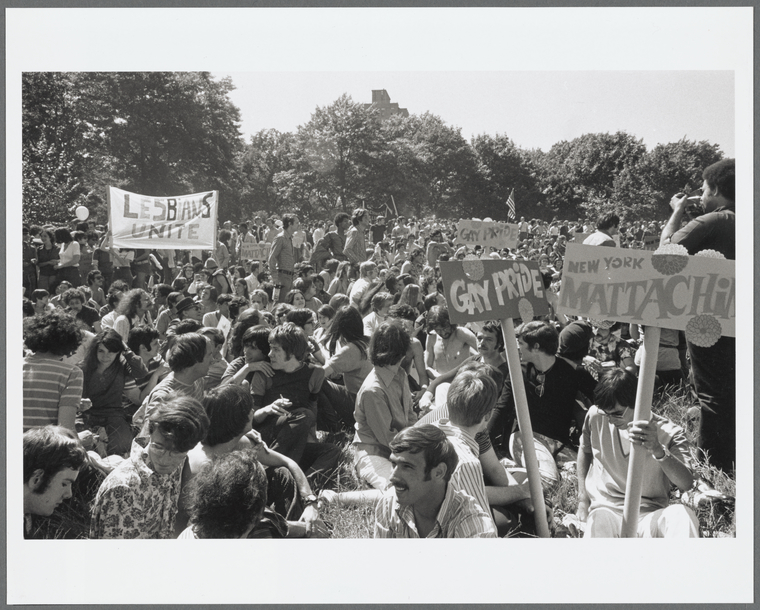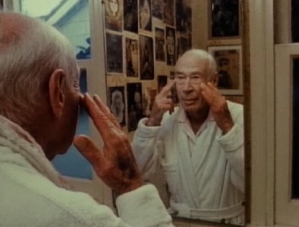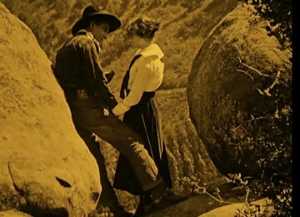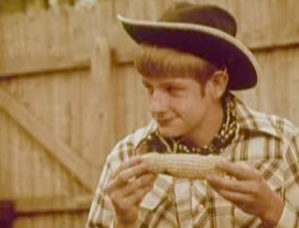Dear air conditioner enthusiasts,
You may have heard that June is LGBT Pride Month in these United States, marked by rainbow-banner parades in cities across the country. Boston’s passed a few Saturdays ago (favorite sign: “gender is a drag,” courtesy of a Traniwreck marcher), but I’ll confess, the parade that still means the most to me is the one in New York City, from Greenwich Village to Central Park, held every year on the last Sunday in June. Part of my fascination is historical—I wonder how many participants and spectators will know that this is the 40th NYC pride parade. The first was held in 1970 in commemoration of the riots outside the Stonewall bar on Christopher Street. (You can read a scan of the Mattachine Society’s account of the riot on sociologist Toby Marotta’s excellent Community Roots Archive. And see some photos from the first Gay Liberation Parade, like the one below, thanks to the New York Public Library’s digital archive, here and here.)
But beyond the political history, NYC’s pride parade still means the most to me because it was one of the crucial ways I tracked my own coming out. In the four years I lived in the East Village and Brooklyn, I never missed the parade, but my reactions to it kept changing. The first summer, I literally stood a few feet back from the main line of spectators, probably afraid some drag queen would literally grab me, pull me over the metal divider, and force to me to march alongside her (or more likely that my face would somehow appear in a local news broadcast). The second summer, I went with a new set of friends, and cheered on a group I meekly referred to, literally, as “lesbians on motorcycles,” not quite ready to embrace their more common moniker. And the third and fourth summers, I went with my boyfriend—though those two honestly start to blur together, which in itself feels like progress.
I went back to grad school, in part, because I wanted to learn more about the cultural history I felt myself to be a part of—a pursuit in which my laziness has been, and remains, key. The latest case in point: OutHistory’s Since Stonewall Local Histories Contest. The online archive invited readers to post their own exhibits, and the results are pretty extraordinary. Where else could you find a history of LGBT visibility in Bloomington, Indiana—now billing itself as the “fifth gayest place in America”? Or a look at FTM trans mentorship in San Francisco? Or photos from the 1978 Reno Gay Rodeo?
 For a lesson in more recent history, you can also spend hours digging through the complete run of Outweek. Though it only lasted from 1989 to 1991, Outweek was an important voice in AIDS activism and awareness, taking a more militant approach than the older Advocate (particularly as co-founder Michaelangelo Signorile began “outing” high-profile sorts). It’s worth downloading some PDFs, just for the ads and cartoons. (FYI: You can also view issues of The Advocate from 1994 to 2006 and Out, co-founded by Outweek columnist Michael Goff, from 1999-2006 on Google Books.)
For a lesson in more recent history, you can also spend hours digging through the complete run of Outweek. Though it only lasted from 1989 to 1991, Outweek was an important voice in AIDS activism and awareness, taking a more militant approach than the older Advocate (particularly as co-founder Michaelangelo Signorile began “outing” high-profile sorts). It’s worth downloading some PDFs, just for the ads and cartoons. (FYI: You can also view issues of The Advocate from 1994 to 2006 and Out, co-founded by Outweek columnist Michael Goff, from 1999-2006 on Google Books.)

 To view an archive in the making, you should also check out I’m From Driftwood, featuring an impressive range of true LGBT tales. Think of it as a queer Storycorps, which of course has its own share of queer tales.
To view an archive in the making, you should also check out I’m From Driftwood, featuring an impressive range of true LGBT tales. Think of it as a queer Storycorps, which of course has its own share of queer tales.
And one last thing for you theatrical types: a re-mastered video of the great Charles Ludlam’s silent (and campy) horror film Museum of Wax, thanks to the Outfest Legacy Project.
Yours fabulously,
Stephen

 What digital resources do you rely on, or would you recommend?
What digital resources do you rely on, or would you recommend?
 The archive also includes some fascinating (if sometimes slow) profiles of artists, including
The archive also includes some fascinating (if sometimes slow) profiles of artists, including 




 The nominations are in! No, not for the Oscars or the Golden Globes, but the awards we’ve all been waiting for: The
The nominations are in! No, not for the Oscars or the Golden Globes, but the awards we’ve all been waiting for: The  The search for meaningful spiritual connection is, of course, nothing new among American Jews. Just take a case in point from the late nineteenth century (how do you like that segue?!): the
The search for meaningful spiritual connection is, of course, nothing new among American Jews. Just take a case in point from the late nineteenth century (how do you like that segue?!): the 





